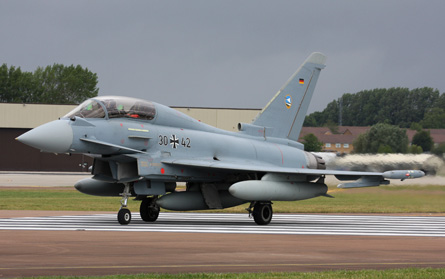Two of the air force chiefs from the launch Eurofighter nations have underlined their services' continued commitment to the programme, and say they want to field new capabilities with the aircraft.
Speaking at the Royal International Air Tattoo on 18 July, Air Chief Marshal Sir Glenn Torpy, the Royal Air Force's outgoing chief of the air staff, singled out the introduction of an active electronically-scanned array radar and extended-range capability as key requirements for future Typhoon orders. "E-scan is being developed, and we would like to add conformal fuel tanks," he says.
Torpy says the RAF has received 56 Eurofighters to date, including seven Tranche 2 production examples. "In terms of performance we are absolutely delighted with them," he says, but confirms that over the long term "we will probably consolidate around the Tranche 2 and Tranche 3 fleets".
 |
|---|
© Craig Hoyle/Flight International |
The UK is close to signing a Tranche 3A contract for the Eurofighter, along with partners Germany, Italy and Spain. The nations' combined requirement covers 112 new aircraft.
German air force chief of staff Lt Gen Klaus-Peter Stieglitz says his service is also interested in fielding multirole Eurofighters equipped with AESA sensors. "The Luftwaffe is looking for the E-Scan radar in the future," he confirms, adding: "We will further evolve and develop the Eurofighter."
Stieglitz says Berlin is still "looking for around 180 Eurofighters", its stated launch commitment to the programme, with this to include 31 Tranche 1 aircraft. "It is not our intention to take these to Tranche 2/3 standard," he says. "There is no immediate need or pressure to convert them."
Seventy German pilots have now converted to the Eurofighter, including 20 instructors, and the type has amassed more than 11,000 flight hours in Luftwaffe service without an accident.
 |
|---|
© Dragon Lady's Gallery on flightglobal.com/AirSpace |
Germany will for the first time send Eurofighters to Lithuania in September-October this year to provide air policing cover for the Baltic states. "This indicates that I trust the system," says Stieglitz. "We meet and beat NATO standards by far in availability, maintainability and reaction time."
Torpy says the RAF "will take stock in around 2012" on whether to deploy the Typhoon to relieve its Panavia Tornado GR4 force, which was recently committed to support NATO-led operations in Afghanistan.
Meanwhile, the Typhoon programme's launch export customer has completed its first 1,000 flight hours with the type. Twelve interceptors have been delivered to the Austrian air force's Zeltweg air base, with its remaining three to be handed over "during the coming months", the Eurofighter consortium says.
Source: Flight International



















